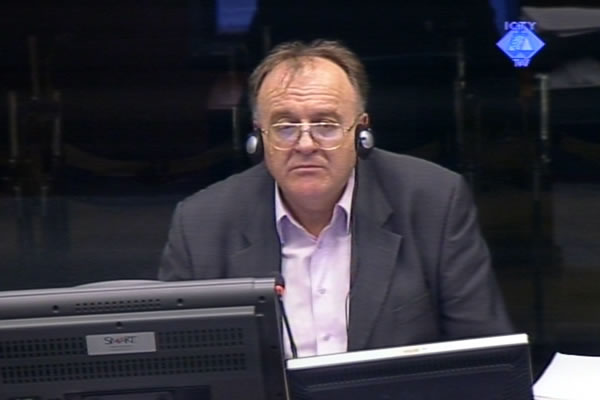Home
HOW HADZIC DECIDED TO GO TO WAR WITH CROATS
In his evidence, former president of the Serb Autonomous Region of Western Slavonia Veljko Dzakula said that Goran Hadzic was at first 'tolerant, democratic and ready to negotiate with the Croatian authorities'. After he was arrested in Plitvice on 31 March 1991 and beaten in a Croatian prison, Hadzic took a more radical position and decided to 'go to war with Croats because he doesn't see a way the two ethnic communities could live together'
 Veljko Dzakula, witness at the Goran Hadzic trial
Veljko Dzakula, witness at the Goran Hadzic trial Through the evidence of Veljko Dzakula, president of the Serb Democratic Forum in Croatia, the prosecution wants to present the context of the crisis in the former Yugoslavia. The crimes Hadzic is charged with happened there. On the first day of his evidence, Dzakula described the events in 1990 and 1991 when three Serb autonomous regions were established: the Serb Autonomous Region of Western Slavonia with Dzakula as its president, the Serb Autonomous Region of Slavonia, Baranja and Western Serb where Hadzic served as prime minister and the Serb Autonomous Region of Krajina headed by Milan Babic.
When the Croatian Democratic Community came into power, Serbs set up their political and military organization to fight against Croatia’s secession, Dzakula recounted. The first roadblocks were put up in the Knin Krajina in August 1990, and were followed by more roadblocks in other areas with a Serb majority. Then local Territorial Defense was established, Dzakula said, the JNA took the Serb side and volunteers from Serbia started arriving. Members of those three military groups are implicated in the crimes in Eastern Slavonia that Hadzic is charged with.
The first major incident happened in the night of 30 March 1991, when armed Serbs and Croatian police clashed in Plitvice. After the clash, Goran Hadzic and Borivoje Savic were arrested near Plitvice on their way from a meeting of the SDS Main Board in Obrovac. Dzakula said that he immediately called his acquaintance, Croatian interior minister Slavko Degoricija and asked him to release all his fellow party members. Dzakula was told that they had been badly beaten and would be released once they were no longer ‘black and blue’ in the face.
Some 20 days later they were indeed released, but in the meantime Goran Hadzic's attitudes became more radical, the witness noted. From a 'tolerant and democratic' politician advocating dialogue at the meeting in Obrovac immediately before his arrest, Hadzic turned into an extremist who was no longer willing to talk and look for compromise solutions. Dzakula went on to describe his meeting with Hadzic in June 1991 in Belgrade. Hadzic told him that he had decided to 'go to war because he doesn't see a way to live together with Croats' because he 'doesn't trust them anymore', Dzakula claimed. The conflict intensified and until the end of 1991, Serbs conquered most of the areas they considered to be theirs and the war spilled over to most of Croatia.
Describing the situation in Western Slavonia, where he was in charge, Dzakula said that he and other moderate politicians were under intense pressure and were receiving threats. Power was actually in the hands of the extremists from the Territorial Defense who enjoyed the support of the JNA and volunteers sent in from Serbia by Vojislav Seselj and his party. At that time, many crimes were committed against Croats in Western Slavonia but also against Serbs in the territory under Croatian control, the witness said. Several letters in which the local Territorial Defense asked Seselj to send them more personnel were admitted into evidence. Dzakula said that in October 1991, Seselj visited his volunteers in Western Slavonia.
In late 1991, the Vance plan was tabled. The plan called for the cessation of hostilities, the deployment of a UN peace keeping force and the return of refugees. The authorities in Belgrade headed by Milosevic were ready to sign the plan but all three Serb leaderships from Croatia opposed it at first. After several meetings in Belgrade, Milosevic and his associates managed to persuade Dzakula and Hadzic to sign the plan. Only Milan Babic remained adamant and refused to sign. As a result, Babic was soon 'removed' from the post of the Krajina president on the orders from Belgrade. The SAO Krajina Assembly then voted to accept the Vance plan.
Hadzic took the advice of the leadership from Belgrade without much hesitation, but continued making extremist statements. In a video recording the prosecution played today in court, Hadzic says after signing the plan that he could hardly wait for the ‘blue helmets’ to be deployed, adding that he would soon get fed up with the ceasefire violations by the other side. If they didn't stop, Hadzic would 'have to embark on an all-out war and penetrate deeper into the Croatian territory'. Dzakula said that such 'extremist statements only served to fuel hostilities’.
Veljko Dzakula continues his evidence tomorrow.
Linked Reports
- Case : Hadzic
- 2012-10-17 ‘THERAPY SESSIONS’ IN DALJ PRISON
- 2012-10-16 TRIBUNAL'S LAST TRIAL BEGINS
- 2012-10-15 FINAL PREPARATIONS FOR HADZIC TRIAL COMPLETED
- 2012-10-19 ‘NO CONDITIONS FOR RETURN, BUT NO EFFORT TO PUT THEM IN PLACE’
- 2012-10-22 DZAKULA: 'SERBS' COMMITMENT TO WAR BENEFITED CROATIA'
- 2012-10-23 HADZIC'S AUTHORITIES OBSTRUCTED RETURN OF CROATS AND SERBS
